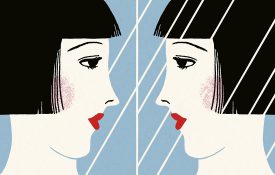-

New Research From Clinical Psychological Science
A sample of research exploring pain and self-injury, associative activation and false memories, flashbacks in PTSD, and a potential contributor to obesity.
-
Waiting game: An extended look at how we queue
Many of us experience multiple queues on an average day. If they move quickly, they're soon forgotten. But a slow line can seem to last forever and can put a drag on an entire day. What separates a good queuing experience from a bad one, however, is not just the speed of the line. How the wait makes us feel and line fairness (nobody likes line-jumpers) can have a greater impact on our perception of a queue than the amount of time we spend in it.
-
Liberals and Conservatives React in Wildly Different Ways to Repulsive Pictures
Why do we have the political opinions we have? Why do we embrace one outlook toward the world and not another? How and why do our stances change? The answers to questions such as these are of course complex. Most people aren’t reading policy memos to inform every decision. Differences of opinion are shaped by contrasting life experiences: where you live; how you were raised; whether you’re rich or poor, young or old. Emotion comes into the picture, and emotion has a biological basis, at least in part. All of this and more combines into a stew without a fixed recipe, even if many of the ingredients are known.
-
The Math Behind Successful Relationships
Nearly 30 years ago, a mathematician and a psychologist teamed up to explore one of life’s enduring mysteries: What makes some marriages happy and some miserable? The psychologist, John Gottman, wanted to craft a tool to help him better counsel troubled couples. The mathematician, James Murray, specialized in modeling biological processes. It was a match made in heaven. The pair decided to create a mathematical model to quantify how couples interact and influence each other during an argument. The results helped Dr. Gottman visualize the dynamics of a marriage and measure the impact of therapy. The approach also proved to be shockingly accurate at predicting which couples would divorce.
-
Frans de Waal Embraces Animal Emotions in ‘Mama’s Last Hug’
The two old friends hadn’t seen each other lately. Now one of them was on her deathbed, crippled with arthritis, refusing food and drink, dying of old age. Her friend had come to say goodbye. At first she didn’t seem to notice him. But when she realized he was there, her reaction was unmistakable: Her face broke into an ecstatic grin. She cried out in delight. She reached for her visitor’s head and stroked his hair. As he caressed her face, she draped her arm around his neck and pulled him closer. The mutual emotion so evident in this deathbed reunion was especially moving and remarkable because the visitor, Dr. Jan Van Hooff, was a Dutch biologist, and his friend, Mama, was a chimpanzee.
-

You Recognize Your Face Even When You Don’t “See” It
Research suggests that certain stimuli – specifically, your own face – can influence how you respond without you being aware of it.

